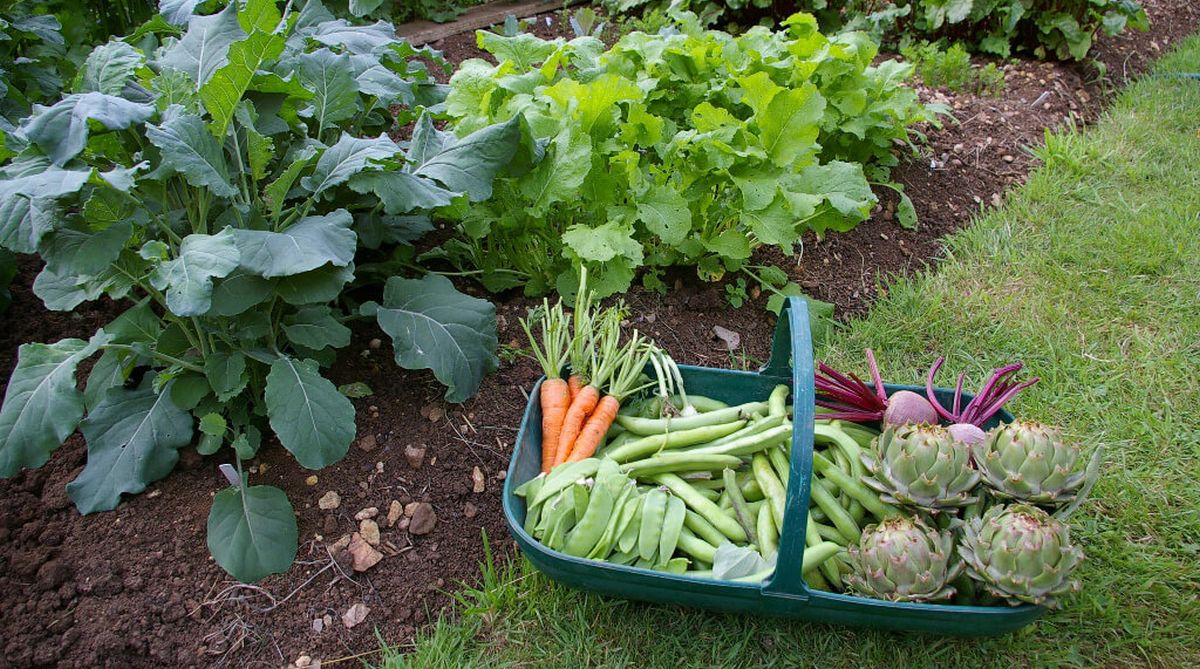Do you want to harvest your own home-grown vegetables this winter? Growing your own is not that complicated as you think. Learn how to grow a plentiful container vegetable garden. It will save your money, taste better, provide you with nutrition and good health and you will be having a full proof knowledge of the source.
Radish: The crunchy, peppery radish can enhance the taste of winter salad. They are easy to grow in containers or sow them directly into the ground. Sow radish seeds about ½ inch deep and 1 inch apart. As radish starts growing, water them frequently and evenly. Keep the radish beds moist rather than soaked. The soil needs to be rich in organic matter. Plant it in a sunny spot. Harvest when the roots are approximately 1 inch in diameter at the soil surface. Pull out one and test it before harvesting the rest.
Spring onion: Spring onion gives a tangy crunch to any salad or stir fry vegetable. They are easy to grow in pots or in the ground. Choose safe certified organic non-hybrid seeds. Sow 1/5 inches deep, five millimetres apart and about 15 centimetres apart in rows. It requires a well-drained, humus rich soil that should be loose. Add compost. Spring onions love regular watering, a sunny position and a liquid fertiliser two to three times while growing. Harvest the whole plant when the leaves are tall, green and healthy looking.
Tomatoes: They are the ideal vegetable to cultivate in your garden. Choose a bush variety that does not require training or side-shooting. You only need to feed and water them before the fruits start to pour from the plant. You may sow them in bags, pots or soil. They require a position in full sun and sufficient water. The soil should be very fertile which provides moisture without water logging. Add plenty of well-rotted manure at planting time. Pick as soon as the fruits are ripe. You can identify it by their colour and size. Use them fresh for the best flavour.
Beetroot: It is a super-easy to grow root vegetable. It tastes good in salads and vegetable juices giving them a bright tempting colour. You can boil them to eat them soft and warm. Beetroot can directly be sown into moist soil and thin seedlings to about five centimetres apart. Grow them in a nice, loose, fertile soil with plenty of well-rotted organic matter. They are always kept well-watered. The sweetest beets are not bigger than a tennis ball and can be pulled easily when they have reached the required size. Larger beets can also be grown if required.
Spinach: Spinach is one of the most nutritious healthy greens. It grows well in winter season. It can be sown in a container or in the ground. Sow the spinach seeds thinly in rows spaced about one to one and a half ft. apart. Cover lightly with soil, firm in place and water well. Keep the soil moist until germination. Once the plants have grown their leaves, you can begin to thin them about six inches apart. Choose an area full of sun. Partial shade will also do. Make sure your soil drains well. Test the pH of the soil. Fertilise it well. Cover the seeds with soil and pat lightly. Water thoroughly. As soon as the leaves grow big enough to eat, you can harvest them.
Lettuce: How about not bringing lettuce from store, just plucking it from your garden for that crunchy-fresh taste in your salad. It needs cold weather to thrive. Lettuce can handle moderate light and partial shade. You can sow the seeds in a deep container indoors. It should be able to hold at least three centimetres of soil. Leave about one centimetre of space between the soil and the top of the container. The container should have holes in the bottom so that extra water can flow out. Cover the seeds lightly with soil. Wet the soil little but not too much. Cover the container with paper. Remove it when the seedlings are tall enough to touch it. Now transplant the seedlings into the garden when they are two to three centimetres tall. Take out as much soil as you can with the seedlings. Plant them in the ground in a bigger hole than its roots. Keep watering but not too heavily. They are best harvested when they are tender. Cut off leaf lettuce at ground level so that the inner leaf can keep growing.
Peas: Peas are part of legume family of vegetables. They are well grown in cooler temperature. They prefer a medium well-dug soil with plenty of organic matter. Do not add nitrogen before or after planting as it extracts sufficient nitrogen from the air. Excess of nitrogen can lead to a lot of leafy growth but a reduced pods of peas. Plant them in sunny areas although they can survive in partial shades too. You can sow them in drills four centimetres deep and 10 centimetres wide in soil. Leave 10 centimetres between the rows. Peas are climbing plants and need support to grow well. But they cannot climb a bamboo cane like beans can, they also need lateral support. Harvest them when they are slightly immature – when fully mature they become hard and loose sweet taste. Pick when the pods are bright green and well- filled but there is still a bit of space between the peas.
Broccoli: Growing crisp and delicious broccoli in the chilly months is a nutritive addition to your garden. It has to be grown in a rich and well-draining soil amended with plenty of rich compost and with a pH around 6. You can plant them in mounds to improve drainage. Use organic fertilisers for a good yield. Broccoli needs full sun, at least four to five hours per day. It needs to be kept moist. Plant broccoli seeds about ¼ to ½ inch deep and transplant to the garden in about five weeks. Space broccoli plants about 18 inches apart. When the main broccoli head is several inches in diameter, your crop is ready to harvest.
Parsley: Parsley is the most-used herb in our kitchens. These frilly leaves sitting atop of various dishes add a bright, high note and tie a meal’s flavours. It is very simple to grow this herb. Start from the seeds. Soak the seeds overnight before sowing for a speedy germination. Garden soil should be moist, loamy and well-turned. Incorporate rich compost early in the growing season. Parsley does well both in full and partial sun. Space the seeds nine inches apart. It is best grown around roses, corns, tomatoes and asparagus. Leave the inner stalk when harvesting for the first time – the plant will keep growing. Harvest the parsley roots the second time.
Home grown vegetables are certainly fresher as you do not usually store them for long. Also, you probably do not use pesticides. Store bought vegetables are full of pesticides that may also upset the natural flavour of vegetables. The current surge of interest in the quality and source of food provide us with the zest to grow our own veggies.
The good cooks need the best ingredients. Where better to source those special vegetable delights than from your own garden.











